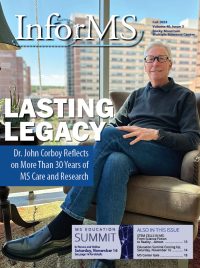
One of the rewarding parts of having such a long career in the field of neurology, as Dr. Corboy has had, is getting to see concepts move from science fiction to science. In the last 15 years, we’ve seen great advancements in the world of stem cell treatments, though the process isn’t yet exactly what we’re hoping it will be in the future.
The true actualization of the science fiction dream would be for stem cell treatments to be neuro-regenerating. That is, the treatment would repair the damage caused by MS, eliminate lingering MS symptoms, and restore mobility and cognitive function by regrowing the bits that have been damaged. That’s still science fiction, we’re not there yet, but read on to see how we’re getting closer.
What are Stem Cells?
Stem cells are special cells that have two essential properties: they can make more of themselves, or self-renew; and they are able to become other cells, to differentiate, and perform different functions. Stem cells can be seen in fetal development, for example embryonic stem cells, and these have the capacity to become all different cell types.
They are also seen in adult organs, and these are limited in how they may differentiate. These stem cells may simply repair the other cells in that particular organ, or differentiate into a limited set of other cells if properly stimulated. Those adult stem cells that are re-programmed to become cells of a different lineage (for example, fat-derived stem cells re-programmed to become cells that may differentiate into nerve cells) are called inducible pluripotent stem cells (iPSCs).
Cells derived from the amniotic fluid of a pregnant woman, or the umbilical cord after a baby is delivered, also have similar properties to stem cells.
What We’re Currently Able to Do
Most of the stem cell studies performed to date in MS have used cells derived from bone marrow that are used to replace cells of the immune system after chemotherapy has removed the potentially damaging autoimmune cells presently in the patient’s body, so as to “re-boot” the immune system.
These hematopoietic stem cells are derived from bone marrow, or from blood after “mobilization” from the bone marrow. Most commonly, the patient uses their own cells, known as autologous hematopoietic stem cell transplant (aHSCT), but some protocols are being studied using those derived from donors (allogeneic stem cells).
Although stem cell therapy is not a standard-of-practice, first-line treatment for anyone yet, many research institutions have had success with high dose chemotherapy followed by aHSCT in MS. The goal of this process is to induce long-term, drug-free, and symptom-free remission in the patient.
aHSCT and allogeneic stem cell transplant use a conditioning regimen of high-dose chemotherapy which carries a low but important risk of potentially very serious infections, and vaccinations will need to be re-administered after the procedure. This intense treatment is not a guarantee that you will remain free of new MS activity, and anyone who undergoes it should continue to be followed by an MS specialty neurologist after the procedure.
In the studies that have been done using high dose chemotherapy followed by aHSCT, the best results have been seen in patients who are younger and in the relapsing-remitting phase of MS (RRMS), have active disease, and for whom prior therapies have failed to slow disease activity. The outcomes for older, non-relapsing, progressive MS have been disappointing.
In 2017, a retrospective analysis of 281 MS patients who underwent high-dose chemotherapy and aHSCT between 1995 and 2006 was published. It found that almost half of the patients remained free from neurological progression for five years after the treatment, and that a younger age, a relapsing form of MS, fewer prior immunotherapies, and lower baseline EDSS scores (lower starting disability) were factors associated with better outcomes.
Also published in 2017, the results of the HALT MS trial only included patients with relapsing-remitting MS and found that high-dose immunosuppressive therapy and aHSCT without maintenance therapy was effective for inducing long-term sustained remissions of active RRMS at five years. This was a Phase II, open-label, single arm study that only included 25 patients.
BEAT MS
BEAT MS is a currently enrolling, randomized, controlled, multicenter trial aiming to compare chemotherapy followed by aHSCT to the most effective medicines regularly used to treat relapsing MS (“best available therapy”). The purpose of this study is to compare the safety and efficacy of the broadly different approaches: a single intervention with an aggressive therapy, compared to more standard ongoing, intermittent therapy with medications such as Ocrevus and Tysabri.
A Note of Caution
There are many clinics around the world that advertise stem cell therapy; however, these treatments may not be reviewed by the FDA and the clinics may not be qualified to deliver such treatments. aHSCT as discussed above is not medical tourism (the practice of traveling outside of the United States to obtain medical treatment).
Stem cell tourism is a major component of medical tourism with clinic locations offering stem cell treatments in several countries. Most of these locations are not participating in clinical trials, do not report their results in medical journals, and the nature and source of the stem cells remains unclear.
Given the present experimental status of stem cell approaches in MS, it is best to restrict participation to those sites that are associated with and overseen by larger academic medical centers.
While in recent years the transplanting physicians have had much greater success in obtaining insurance coverage for aHSCT, this is not always the case, and costs exceed $100,000. Medical procedures done in countries outside of the United States are usually not covered by insurance and can require cash payments.
In addition to being expensive, unapproved or unregulated procedures can carry risks of infection, tumors, or even death. The evidence for any specific treatment is at best very limited and there is no guarantee that you will see any results.
Within the United States, there are also clinics operating who advertise stem cell treatments without being qualified to do so or reviewed by the FDA. You can search the FDA’s website for information on therapies available in the US that you may be considering. However, the FDA doesn’t cover treatments in other countries. You’ll have to check with local regulatory agencies in the country or jurisdiction you’re looking at, and those may not always be as reliable as the FDA.
What’s on the Horizon
The aHSCT that re-boots the immune system may well become a more commonly-used tool to help reduce the inflammation in MS, but it does little, if anything, to repair damaged nerve cells. The promise of what we think stem cells can do — that is, actually repairing the damage caused by MS — is extremely alluring because we don’t currently have a good approach to dealing with this damage.
Regeneration of nervous system tissue that has been damaged by MS, stroke and other conditions is now being studied. Neural precursor cells — those already headed down the path to make nervous system cells — can be obtained from miscarried fetuses, aborted fetuses (with prominent ethical issues), or can be derived from cells in other organs that are then re-programmed (the iPSCs described above).
Studies in the animal model of MS suggest this approach may be useful for MS patients, but human studies are too early to determine if it will work.
There are at least four groups in the world, however, who have begun studies of this type, including two in the US and two in Italy. In November 2023, Italian researchers found that the injection of embryonic stem cells from a miscarried fetus directly into the brains of patients living with progressive MS was safe and well tolerated. It was a very small Phase One trial, but it’s another step forward in the research of this topic.
Phase One trials are mainly to test safety and do not measure or indicate efficacy. In the future, larger studies will need to be performed to define how long these cells live, how well do they travel to areas of nervous system damage, can they actually repair or regenerate tissue, and determine if this approach is safe. These studies are still risky and experimental and should only be undertaken at centers with substantial experience and expertise, and with protocols that have been reviewed by the FDA.
If You’re Considering Stem Cell Treatment
The most important thing when considering any sort of stem cell treatment is to look for a good, regulated, research study at a reliable institution. Going somewhere that is not qualified to do these procedures is not just potentially ineffective and expensive, it could be damaging long-term and life-threatening.
Conclusion
There are many concerns to be worked through and complications for researchers to solve before our hopes of stem cell treatments to repair MS damage can be realized, but there is a path moving forward. Every discovery brings us closer to answers and may help us learn of other, more easily accessible treatments in the meantime.






